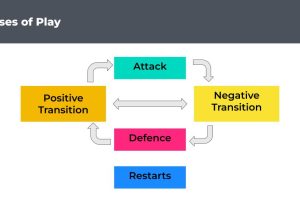Positionism vs Relationism: The Debate on Soccer Tactics Unraveled
Positionism and relationism are two contrasting tactical approaches to soccer that have gained significant attention in recent years. While both approaches aim to optimize player movement and team performance, they differ in their underlying principles and philosophies.
Positionism is a traditional approach where players are assigned specific positions on the field and are expected to maintain these positions throughout the game. This approach emphasizes structure and organization, with players expected to follow a pre-determined game plan. In contrast, relationism is a more flexible approach that emphasizes player movement and interaction. Players are encouraged to interpret space and react to situations in real-time, with less emphasis on fixed positions.
Understanding the differences between positionism and relationism is important for coaches, players, and fans alike. By examining the historical context, tactical differences, and impact on individual and team performance, it is possible to gain a deeper appreciation for these approaches and their potential benefits and drawbacks.
Key Takeaways
- Positionism and relationism are two contrasting tactical approaches to soccer that differ in their underlying principles and philosophies.
- Positionism emphasizes structure and organization, while relationism emphasizes player movement and interaction.
- Understanding the differences between these approaches is important for coaches, players, and fans in order to optimize team performance and appreciate the potential benefits and drawbacks of each.
Understanding Positionism and Relationism
Positionism: An Overview
Positional play, also known as positionism, is a tactical approach to football that prioritizes possession-based football. It involves players having clear instructions, roles, and zones to occupy on the pitch. This approach was popularized by Pep Guardiola, who implemented it during his time at Barcelona and Bayern Munich.
Positionism emphasizes the importance of maintaining possession of the ball through intelligent movement and passing. Players are expected to move into specific positions on the pitch to create passing lanes and options. This approach requires a high level of technical ability, as players must be able to control and pass the ball accurately and quickly.
One of the benefits of positionism is that it allows teams to control the tempo of the game. By maintaining possession of the ball, teams can wear down their opponents and create openings for scoring opportunities. Additionally, positionism can be an effective defensive strategy, as it limits the amount of time the opposition has on the ball.
Relationism: An Overview
Relationism, also known as functional play, is an emerging philosophy that changes the way a team is structured on the pitch. It embraces the chaos of a match and is more interested in what the players are doing, how they’re moving, and how they’re connecting with their teammates.
Unlike positionism, relationism doesn’t place as much emphasis on specific positions and roles. Instead, it encourages players to be more fluid in their movement and decision-making. This approach requires players to be comfortable with improvisation and creative problem-solving.
One of the benefits of relationism is that it allows teams to be more adaptable to different situations. By encouraging players to be more flexible in their movement and decision-making, teams can respond more effectively to changes in the game. Additionally, relationism can be an effective offensive strategy, as it creates more unpredictability and can catch opponents off guard.
Philosophy of Football
Positionism and relationism represent two different approaches to the game of football. While both approaches have their benefits, they also have their limitations. Ultimately, the choice between positionism and relationism will depend on the strengths and weaknesses of the team, as well as the philosophy of the coach.
Some coaches believe that positionism is the best approach to football because it allows teams to control the game and limit the opposition’s chances. Others believe that relationism is the way forward because it encourages players to be more creative and adaptable.
In the end, the philosophy of football is about finding the right balance between structure and creativity. Whether a team chooses to adopt a positionist or relationist approach, the most important thing is to have a clear plan and to execute it effectively on the pitch.
Historical Context
Relationism in South America
Relationism in soccer emerged in South America during the 1930s and 1940s. It was a style of play that emphasized ball control, passing, and movement. The focus was on maintaining possession of the ball and patiently building up play until a scoring opportunity presented itself.
The South American style of relationism was heavily influenced by the cultural context of the region. Soccer was seen as a way to express national identity and pride, and the emphasis on ball control and possession was seen as a reflection of the region’s love of dance and music.
Positionism in Europe
Positionism, on the other hand, emerged in Europe during the 1950s and 1960s. It was a style of play that emphasized movement off the ball and positional awareness. The focus was on creating space and exploiting gaps in the opposition’s defense. This style of play was heavily influenced by the Dutch Total Football style of play that Ajax popularized in the 1970s.
The European style of positionism was heavily influenced by the cultural context of the region. Soccer was seen as a way to express individual creativity and innovation, and the emphasis on movement off the ball and positional awareness was seen as a reflection of the region’s love of science and technology.
Overall, both positionism and relationism have had a significant impact on the development of soccer tactics and strategy. While positionism is still dominant in South America, relationism has become increasingly popular in Europe and has been adopted by many of the top clubs in Spain, Germany, and Italy.
Tactical Differences
Positional Play
Positional play, also known as positionism, is a tactical approach in soccer that prioritizes maintaining possession of the ball through structured movement and passing patterns. This approach is characterized by a fixed formation and a focus on maintaining specific positions on the field. The idea is to create space and passing lanes by manipulating the opposition’s defensive structure.
Teams that employ positional play usually play with a high defensive line, which allows them to press the opposition high up the field and regain possession quickly. This requires a high level of technical ability and tactical discipline from the players, as they need to maintain their positions and move the ball quickly and accurately.
A key aspect of positional play is the use of triangles on the field, which allows players to create passing options and maintain possession in tight spaces. This approach requires a high level of coordination and communication between players, as they need to be constantly aware of their positioning and the movement of their teammates.
Dynamic Play
Dynamic play, also known as relationism, is a tactical approach in soccer that prioritizes individual relationships between players over structure and ideas. This approach is characterized by a fluid formation and a focus on creating space through movement and interchanges between players.
Teams that employ dynamic play usually play with a lower defensive line, which allows them to absorb pressure and counterattack quickly. This requires a high level of individual skill and creativity from the players, as they need to be able to create opportunities and take advantage of them quickly.
A key aspect of dynamic play is the use of improvisation and creativity on the field, which allows players to create scoring opportunities out of nothing. This approach requires a high level of trust and understanding between players, as they need to be constantly aware of each other’s movements and be able to anticipate each other’s actions.
Overall, the choice between positional play and dynamic play depends on a team’s strengths and weaknesses, as well as the opposition’s tactics. While positional play is more structured and requires a high level of technical ability, dynamic play allows for more creativity and individual expression on the field. Both approaches can be effective when executed correctly, and teams should choose the approach that best suits their style of play and personnel.
Writer Jamie Hamilton has some great work on relationism, with this medium article being a great starting point.

Role of Time and Space
Time in Positionism
In positionism, time is a critical factor. Players are expected to move quickly and efficiently to create space and opportunities for their teammates. This style of play emphasizes the importance of maintaining possession and controlling the pace of the game. Players are expected to make quick decisions and execute precise passes to maintain possession and create scoring opportunities.
The positionist approach to time is all about efficiency. Players are expected to move into space quickly and make quick decisions with the ball. They are also expected to anticipate the movements of their teammates and make passes that allow them to maintain possession. This approach requires a high level of technical skill and tactical awareness from all players on the team.
Space in Relationism
In relationism, space is the most important factor. This style of play emphasizes the importance of creating space and opportunities for players to move and connect with their teammates. Players are encouraged to move into space and create passing lanes for their teammates. This approach requires a high level of tactical awareness and creativity from all players on the team.
The relational approach to space is all about creativity. Players are encouraged to make unpredictable movements and create space for their teammates. They are also encouraged to take risks and try new things on the pitch. This approach requires a high level of technical skill and tactical awareness from all players on the team.
In relationism, the football pitch is seen as a canvas for players to express themselves and create scoring opportunities. Players are encouraged to move into space and create passing lanes for their teammates. They are also encouraged to take risks and try new things on the pitch. This approach requires a high level of technical skill and tactical awareness from all players on the team.
In conclusion, time and space play critical roles in both positionism and relationism. While positionism emphasizes the importance of efficiency and maintaining possession, relationism emphasizes the importance of creativity and creating space for players to move and connect with their teammates. Both styles of play require a high level of technical skill and tactical awareness from all players on the team.
Influence on Training and Coaching
Training in Positionism
Training in positionism involves a focus on technical drills and repetitive exercises to improve players’ ability to maintain possession and create chances. Coaches who employ this strategy often prioritize passing accuracy and ball control, emphasizing the importance of maintaining a structured formation on the field.
Pep Guardiola, known for his success with Barcelona and Manchester City, is a prominent advocate of positionism. His teams are known for their fluid, possession-based style of play, and he places a strong emphasis on training his players to maintain possession and create scoring opportunities through quick, accurate passing.
Coaching in Relationism
Coaching in relationism involves a focus on individual player creativity and flexibility, allowing players to express themselves on the field and adapt to changing game situations. Coaches who employ this strategy often prioritize individual skill development and encourage players to take risks and make creative plays.
Fernando Diniz, a well-known Brazilian coach, is famous for a positionist approach to training. He focuses on developing players’ technical skills and maintaining a consistent formation on the field, with an emphasis on ball possession and attacking play.
Luciano Spalletti, former coach of Napoli, is known for his use of relationism in coaching. He emphasizes the importance of individual player creativity and flexibility, allowing his players to adapt to changing game situations and take advantage of opportunities as they arise.
Carlo Ancelotti, current coach of Real Madrid, also employs a relationist approach to coaching. He focuses on developing each player’s unique skill set and encourages them to take risks and make creative plays on the field.
Impact on Individual and Team Performance
Individuality in Positionism
Positionism allows for a consistent stream of chances created and provides defensive security. However, it can lead to a lack of individuality in players. In a positionism system, players are expected to adhere to a specific position and perform specific duties, limiting their creativity and individuality.
Individuality is crucial in soccer as it allows players to express themselves and showcase their unique skills. In a positionism system, players may feel restricted and unable to showcase their full potential. This can lead to a lack of confidence, which can affect their overall performance.
Team Chemistry in Relationism
Relationism embraces individuality and champions dynamic, high-octane, attacking football. It allows players to express themselves and encourages creativity. In a relationism system, players are given more freedom to move around the field and express their individuality, leading to a more dynamic and exciting style of play.
However, relationism can lead to a lack of defensive structure and rest defense. Without a structured defensive system, teams can be vulnerable to counter-attacks and conceding goals. Additionally, players may become fatigued due to the high-intensity nature of relationism, leading to a lack of rest defense.
Team chemistry is crucial in soccer, and relationism can help to foster a strong sense of team chemistry. When players are given the freedom to express themselves, they are more likely to enjoy playing together, leading to a stronger sense of camaraderie and teamwork.
Overall, both positionism and relationism have their pros and cons when it comes to individual and team performance. It is up to coaches to determine which system works best for their team and players, taking into account factors such as team chemistry, individuality, attack, defensive structure, and rest defense.
Case Studies
Manchester City and Positionism
Manchester City is a team that has been associated with positionism, a style of play that emphasizes the importance of maintaining a specific formation and structure on the field. Under the leadership of Pep Guardiola, Manchester City has been known for its intricate passing patterns and its ability to control the tempo of the game.
One of the key players in Manchester City’s position-based system is midfielder Luka Modric. Modric is known for his ability to control the ball and dictate the pace of the game. His passing accuracy and vision make him an essential component of Manchester City’s possession-based style of play.
Fluminese and Relationism
Fluminese is a team that has been associated with relationism, a style of play that emphasizes the importance of player movement and improvisation on the field. Under the leadership of coach Roger Machado, Fluminese has been known for its fluid attacking style and its ability to create scoring opportunities through individual skill and creativity.
One of the key players in Fluminese’s relation-based system is forward Lionel Messi. Messi is known for his ability to create scoring opportunities through his individual skill and creativity. His ability to improvise and create scoring opportunities out of nothing makes him an essential component of Fluminese’s relation-based style of play.
Another player who has excelled in Fluminese’s relation-based system is striker Erling Haaland. Haaland is known for his ability to make runs into space and create scoring opportunities through his movement off the ball. His physicality and finishing ability make him an essential component of Fluminese’s attacking style of play.
Future of Positionism and Relationism
Automation and Positionism
The future of football tactics is likely to see an increased use of automation in positionism. With the rise of data analytics and machine learning, teams are able to gather more information about their players and opponents than ever before. This information can be used to create automated systems that optimize player positioning and movement on the pitch.
One potential benefit of automation in positionism is that it can help reduce the risk of errors caused by human decision-making. For example, an automated system could be used to track the movements of opposing players and adjust the positioning of defenders accordingly. This would help reduce the likelihood of defensive errors that can lead to goals.
However, there are also potential drawbacks to increased automation in positionism. One concern is that it could lead to a more rigid style of play that lacks creativity and spontaneity. Additionally, there is a risk that players may become too reliant on automated systems and lose their ability to make independent decisions on the pitch.
Creativity and Relationism
In contrast to positionism, relationism is focused on creativity and improvisation on the pitch. This style of play places a greater emphasis on the interactions between players and their ability to adapt to changing situations.
One potential benefit of relationism is that it can lead to more unpredictable and exciting matches. By encouraging players to be more creative and take risks, relationism can lead to moments of brilliance that can turn a game in an instant.
However, there are also potential drawbacks to relationism. One concern is that it can lead to a lack of structure and organization on the pitch. Without clear instructions and defined roles, players may struggle to work together effectively.
Overall, the future of football tactics is likely to see a continued evolution of both positionism and relationism. While automation may play an increasingly important role in positionism, creativity and improvisation will remain key components of relationism. By finding the right balance between these two styles of play, teams can create a winning formula that is both effective and exciting to watch.
A Combined Approach
In the ever-evolving landscape of soccer tactics, the tug-of-war between positionism and relationism presents coaches with an intriguing dilemma. Positionism, rooted in structure and predetermined roles, seeks to dominate through possession and spatial control. Relationism, on the other hand, revels in fluidity, prioritizing spontaneous player interactions and adaptive movements. While each has its merits, the future of soccer may lie in the synthesis of these philosophies.
Progressive coaches are looking to find a harmonious middle ground where the structure of positionism seamlessly integrates with the dynamic adaptability of relationism. By melding the organization of positional play with the unpredictable nature of relationism, teams can achieve a balanced tactical approach that keeps opponents constantly guessing and allows players to exploit space both through disciplined positioning and creative interplay. This hybrid approach could redefine modern soccer, offering a tactical framework that maximizes the strengths of both philosophies while mitigating their individual weaknesses.
Frequently Asked Questions
What is positional play in soccer and how does it differ from relationism?
Positional play is a tactical approach in soccer that emphasizes the importance of maintaining a specific formation on the field. Players are assigned specific roles and positions, and they are expected to stick to those positions throughout the game. On the other hand, relationism is a more fluid approach that prioritizes the movement and interaction between players over their specific positions. Players are encouraged to be creative and dynamic, and to constantly adjust their positions based on the movements of their teammates and opponents.
How does relationism affect team tactics in soccer?
Relationism can have a significant impact on team tactics in soccer. Teams that adopt a relationist approach tend to focus on possession and maintaining control of the ball. They are often more patient and deliberate in their build-up play, and they place a high value on passing accuracy and movement off the ball. Relationism can also lead to a more attacking style of play, as players are encouraged to take risks and make creative runs in order to create scoring opportunities.
What is the principle of relationism and how is it applied in soccer?
The principle of relationism is based on the idea that the whole is greater than the sum of its parts. In soccer, this means that a team’s success is not just determined by the individual skills and abilities of its players, but also by how well they work together as a unit. Relationism is applied in soccer by encouraging players to focus on their relationships with their teammates, rather than just their own individual performance. This can lead to a more cohesive and effective team, as players are more likely to work together and support each other on the field.
Can a team successfully use both positionism and relationism in their playing style?
It is possible for a team to successfully use both positionism and relationism in their playing style, although it can be challenging to find the right balance. Some teams may choose to use positionism as a foundation, but incorporate elements of relationism when they are in possession of the ball. Other teams may use relationism as a starting point, but fall back on positionism when they need to defend or maintain a lead.
What are the benefits and drawbacks of adopting a relationist approach in soccer?
The benefits of adopting a relationist approach in soccer include increased creativity and fluidity in play, as well as a greater emphasis on possession and control of the ball. However, there are also drawbacks to this approach, such as a higher risk of turnovers and a greater need for individual skill and decision-making. Additionally, relationism can be more challenging to implement and requires a high level of teamwork and communication between players.
How has relationism influenced the tactics and strategies of modern soccer teams?
Relationism has had a significant influence on the tactics and strategies of modern soccer teams. Many top-level teams now prioritize possession and passing accuracy, and they place a greater emphasis on fluidity and movement off the ball. Additionally, relationism has led to a greater focus on individual player development, as teams look for players who can excel in a more dynamic and creative playing style.







